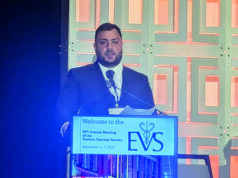A recently published study has shown that lower limb bypass surgery offered a significantly higher probability of amputation-free survival and wound healing compared with endovascular treatment in patients with chronic limb-threatening ischemia (CLTI). This and other key findings from the study are reported in the European Journal of Vascular and Endovascular Surgery (EJVES).
The research group, led by Jean-Baptiste Ricco, MD, PhD, professor of vascular surgery at CHU de Poitiers in Poitiers, France, aimed to compare the long-term efficacy of lower limb bypass with that of endovascular treatment in patients with CLTI.
Ricco and colleagues conducted a retrospective, multicenter study with propensity analysis to evaluate the outcomes of patients with CLTI who underwent first-time infrainguinal bypass or endovascular treatment. In the methods section of their paper, the authors elaborate that the retrospective cohort study design was employed using hospital charts of patients treated between January 2015 and December 2021 in four European vascular centers—three in France (the University of Poitiers, the University of Clermont-Ferrand and the University of Toulouse) and one in Italy (the University of Rome, Sapienza).
They detail that the primary outcome was to compare amputation-free survival rates between the two propensity score matched groups. The secondary outcome was to compare wound healing within the first six months. Major adverse events were compared according to the type of revascularization, Ricco et al note.
The authors share that, overall, 793 patients fulfilled the eligibility criteria, from whom 236 propensity score matched pairs were analyzed. They specify that the 236 bypass procedures included 190 autogenous bypass grafts (80.5%), 151 (64%) of which were infrapopliteal. The mean follow-up was 52 months.
Ricco and colleagues add that, among the 236 endovascular treatment procedures, the target lesion was the femoropopliteal segment in 81 patients (34.3%), the femoropopliteal and infrapopliteal segments in 101 patients (42.8%), and the infrapopliteal segment in 54 patients (22.9%).
The investigators report in EJVES that amputation-free survival was significantly better in the bypass group at five years (60.5±3.6%) compared with the endovascular treatment group (35.3±3.6%), citing a p value of 0.001.
Furthermore, they reveal that major amputation occurred in 61 patients (25.8%) in the bypass group and 85 (36%) in the endovascular treatment group (hazard ratio 0.66, 95% confidence interval 0.47–0.92; p=0.14).
In other results, Ricco et al share that the probability of healing was significantly better in the bypass group at six months compared with the endovascular treatment group (p=0.003) and that the median length of stay was shorter for the endovascular treatment group (four days) than for the bypass group (eight days) with a p value of 0.001. Finally, they detail that urgent reintervention and readmission rates were high and did not differ significantly between the groups.
In the discussion section of their paper, Ricco and colleagues acknowledge some study limitations. They write, for example, that this was a retrospective study and, “despite propensity score matching, the possibility of unmeasured confounders cannot be excluded”. They also recognize that disparities in state funding of French and Italian university hospitals did not allow conduct of a cost analysis of the endovascular therapy and bypass groups.
Also in their discussion, Ricco and colleagues touch upon the significance of the outcome measures used in the study. Amputation-free survival and ischemic wound healing rates are two outcomes of “primary importance” for CLTI patients, they state. “Most previous studies have focused on survival, limb salvage, or amputation-free survival, but these outcomes cannot determine whether, and after how many weeks, wound healing is achieved in patients with CLTI. In this study, amputation-free survival and wound healing together made it possible to assess the effectiveness of revascularization,” the authors elaborate.
The investigators also consider the context of the recently published BEST-CLI trial, which they note provides “substantial clarity” about the midterm outcome—2.7 years median follow-up—showing a lower incidence of a major adverse limb event or death in bypass patients compared with the endovascular treatment group. The authors write, “The present research supports these results with 80.5% of autogenous bypasses made possible by systematic pre-operative DUS assessment of saphenous veins and arm veins, together with the deliberate choice of a bypass inflow located downstream from the common femoral artery in 62.3% of patients with a combination of SFA angioplasty above a distal origin graft allowed the patient to be offered autogenous grafting to a distal target.”
They highlight several similarities and differences between the BEST-CLI and the present study. For example, they note that both included the use of up-to-date endovascular techniques such as drug-coated balloons or drug-eluting stents, citing figures of 62% and 60.6%, respectively. On the other hand, they note that mean follow-up was a point of difference between the two studies, with follow-up being 52 months for the present study compared to 32 months for BEST-CLI.
In their conclusion, Ricco et al stress that their results provide “strong positive evidence” that patients receiving bypass surgery for CLTI have a “significantly higher probability” of amputation-free survival and wound healing compared with patients treated with an endovascular procedure. They reiterate that the rate of urgent reintervention and readmission remains high for individuals receiving either procedure.












